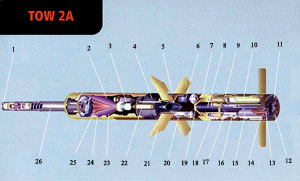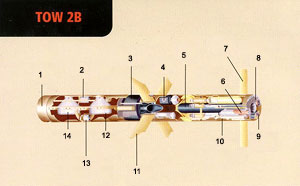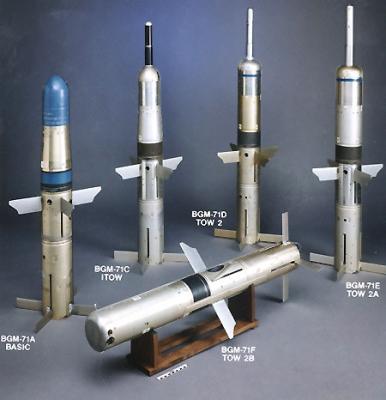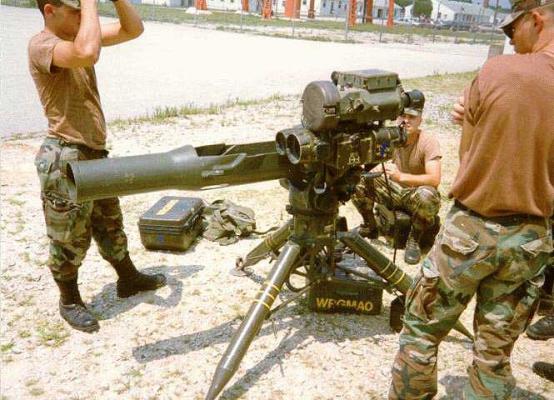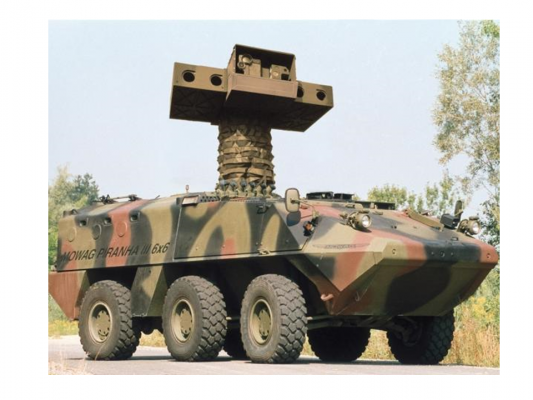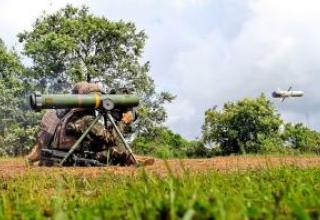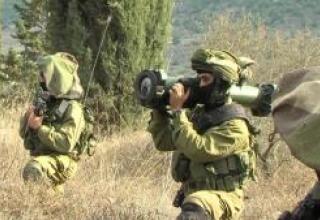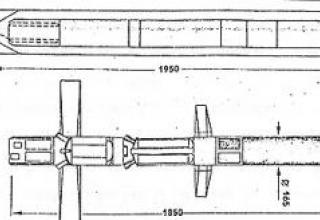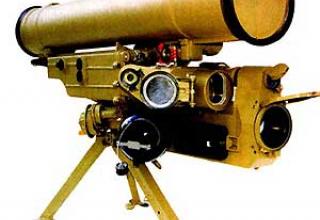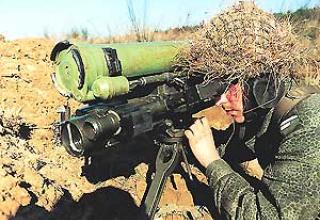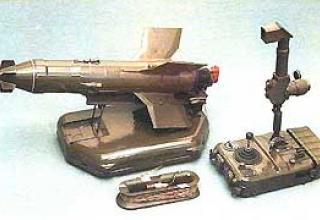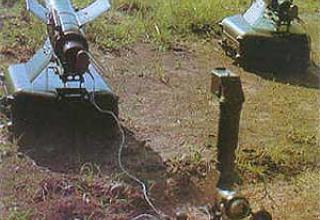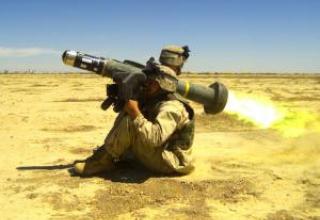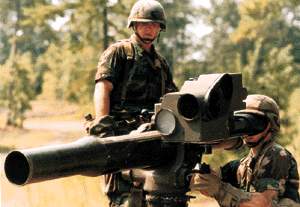
Adopted for service in 1969, the TOS complex is the main anti-tank guided weapon of the U.S. Army (Army and ILC). It is used as an infantry weapon, for arming the AN-1S and AN-1 Sea Cobra helicopters, Bradley BMP, as well as in the self-propelled missile launcher M901 ITV and others.
The complex has been repeatedly upgraded and improved. Thus, in response to the use of the probable enemy composite armor was adopted by the missile TOW-2, equipped with a large-caliber ballistic missile with a tip in the head end to detonate the explosive charge at an optimal distance from the obstacle. The appearance of jet armor was the reason for the development (since 1986) missiles TOW-2A and TOW-2B.
According to foreign experts' estimates, more than 600 thousand TOW-2A and TOW-2B missiles of all modifications had been produced by the year 2000 and are in service in more than 40 countries. In particular, according to the Komsomolskaya Pravda newspaper for April 5, 1988, TOW anti-tank guided missiles were supplied to Afghan opposition groups in Pakistan.
Composition:
TOW-2A is a further upgrade of TOW-2. Unlike the TOW-2 PTUR missile TOW-2A is equipped with a new tandem design BC developed by the Armament Research Center together with the TOW PTUR design bureau. Hughes Aircraft has merged the TOW-2 missile and the new BC, and developed a new algorithm for calculating the missile's flight path.
In the tandem BC the TOW-2 PTUR main explosive rechargeable charge with two cone claddings of the cumulative hollow, which has an effective effect on steel, composite and even reactive armor. A small additional (auxiliary) cumulative charge with a diameter of 38 mm (at a distance of about 30 cm from the main one) and weighing about 300 g is installed in the front part of the telescopic tip of the BC with a diameter of about 50 mm. The mass of the main charge is 5.896 kg. When the missile collides with the purpose of additional charge is undermined, forming a jet of molten metal and gas and exploding reactive armor explosives. The cumulative jet of main explosive charge through the formed holes in the rocket armour provides penetration of the main armour of the tank. The diameter of the BC is 152.4 mm.
A mechanical switch located at the tip's head end and triggered in the event of an impact on the barrier delays the main explosive charge detonation after the jet armour is detonated and destroyed by the auxiliary charge. The main explosive charge is detonated at a distance of about 450 mm from the barrier.
The next modification of the missile is TOP-2B with a semi-automatic control system by wire. It is equipped with optical (laser rangefinder) and magnetometer sensors, as well as BC with two charges acting on the principle of "shock core". The charges (diameter of each 149 mm) are detonated by the fuses simultaneously and hit the target from above, in the least protected part of the case.
In appearance TOW-2B missile is similar to TOW-2A, but equipped with a new modified BC with double cumulative charge, the action of which is directed at an angle to the longitudinal axis of the missile, and a remote magnetic (or magnetic - IR) fuse with a laser or radio frequency rangefinder. The BC is detonated at a certain point as the missile flies over the target. The diameter of the BC compartment is the same (152.4 mm) as for the previous TOW missile model, but the cumulative charges differ significantly.
The BC design is considered, containing two warheads with high kinetic energy EFP (Explosively Formed Projectile) shaped by the explosive energy of the BB and calculated also for top engagement. The complex technical challenge in implementing this BC principle of operation is to ensure that it triggers over the most vulnerable part of the tank, as the armour-piercing capability of the hitting element is relatively low. It is approximately equal to the diameter of the BC, while for cumulative BCs it is up to six diameters.
Changes were made in the mathematical support of the guidance system of the complex to ensure the compatibility of the TOW-2B missile with existing PU and equipment and the flight of the missile along the decking trajectory above the sighting line. The missile engine is the same as that of TOW-2A and guidance system with the transfer of commands over wires.
The development of the remote fuse with a rangefinder was entrusted to Fairchild and Honeywell, and the new BC to Aerojet.
Hughes is working with a radio beam guidance system operating in the millimeter wavelength range as part of a program to develop a new guidance system (without the use of wires to transmit commands).
The elimination of the wires in the guidance system removes the range and velocity limitations of the missile, imposed by the unwinding mechanism from the reel, and allows increased acceleration in the acceleration section. As a result, the range of the missile can be increased, the time of its flight can be reduced, and the angle of attack of the missile in flight can be reduced (hence, the armor penetration of BC in frontal attack of the target will increase). The missile's flight speed will be supersonic (the maximum speed of existing missiles is 200 m/s). The mass of the missile will remain approximately the same as the mass of the guidance system unit.
In mid-1988, the company conducted the first successful test launch of a missile with a guidance system in the millimetre range. The rocket, which was equipped with an inert BC, hit the target precisely at its maximum range.
Characteristics:
| TOW-2A | TOW-2B | |
| Range of fire, m | 3750 | 3750 |
| Time of flight to the maximum range, s | 20 | 21 |
| Body diameter, mm | 149 | 149 |
| The length of the rocket, mm | 1280 | 1219 |
| Start weight, kg | 24.50 | 22.60 |
Testing:
The complex proved itself well in combat operations, in particular, a significant number of TOS-2 and TOS-2A missiles were used during the combat operations in the Persian Gulf area in 1991. According to the estimates of the foreign press, one of the Marine Corps units destroyed 93 armored targets, while using 120 vehicles.
The modernization of this complex is currently in progress. The works are aimed at further increasing the combat efficiency of the MANPAD, reducing its mass and dimensional characteristics and the amount of equipment included in its composition.
For example, a new ITAS launcher was developed on the instructions of the Ground Forces Command. Its main difference from the basic model is that all devices are combined into a compact unit, it uses a new combined sight, laser rangefinder and improved missile control equipment. Technical capabilities of the sight allow to engage targets in any visibility conditions at the maximum range of missile launch. In addition, it has advanced lifting and rotating mechanisms, as well as diagnostic and training equipment.
Raytheon has started to develop a missile capable of hitting targets on a "shot for forget" basis. It plans to develop a propulsion system using gel fuel, a more powerful BC, and a new thermal imaging homing head. At the same time, the missile should remain compatible with all TOW systems, including ITAS, and its launch range is expected to be at least 5 km.
Modernization of TOS complexes is carried out in other countries as well. In Denmark, for example, ETS (Elevated Tow System) has been successfully tested to verify that ETS can be launched from behind a shelter. This system is capable of engaging armoured fixed and moving targets at a range of up to 4 km with TOP missiles of all modifications. ETS is a tracked armored vehicle M113A1 with a stabilized platform rising to a height of 7 m, which combines into a single compact unit optronic system and PU for four missiles in the armored body. The platform is elevated to the required height for reconnaissance purposes and for launching PTUR by means of a hydraulic drive from a camping position.
The optical-electronic system includes a combined sight with optical and thermal channels with a tracking system, a laser rangefinder and a unit of the missile's flight control equipment. In addition, the advanced lifting and turning mechanisms of the PU ensure that the platform turns in two-speed mode. All incoming information is displayed on the displays of the commander and gunner-operator of the complex, located at workstations inside the APC. This complex is capable of carrying 20 missiles, four of which are in the AP platform. Recharge of missiles can be carried out in automatic and manual modes.
According to the developers, the installation of the platform with a lifting mechanism is also possible for other types of combat vehicles, in particular, the LAV series.
Sources:
- Протасов Н.Г. Противотанковые ракетные комплексы основных капиталистических государств (Обзор по материалам открытой зарубежной печати). Л.: ЛМИ, 1990.
- Комсомольская правда. №79(19179). Вторник. 5 апреля 1988 г. - С.3.
- Army Times. - 1987. - Vol. 47, № 51. - P. 26, 27
- International Wehrrevue. - 1988. - Vol. 21, № 1. - S. 44, 45
- Aviation Week. - 1987. - Vol. 127, № 4. - P. 23
- Military Technology. - 1987. - Vol. 11, № 9. - P. 114
- Truppendienst. - 1987. - № 6. - S. 650
- Missile/Ordnance Letter. - 1988. - № 800. - P.6
- Air et Cosmos. - 1988. - № 1190. - P. 46
- Jane's Defense Weekly. - 1988. - Vol. 10, № 5. - P. 198
- Defense. - 1988. - Vol. 19, № 7. - P. 526
- Military Technology. - 1988. - Vol. 12, № 6. - P. 103
- Air et Cosmos. - 1988. - № 1200. - P. 44
- Defense News. - 1988. - Vol. 3, № 33. - P. 32
- Air et Cosmos. - 1988. - № 1204. - P. 34
- Military Technology. - 1987. - Vol. 11, № 12. - P. 35,36,39-40
